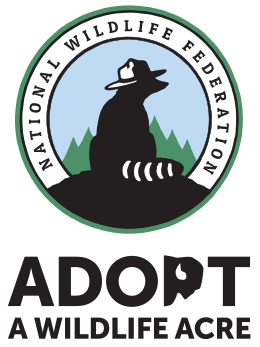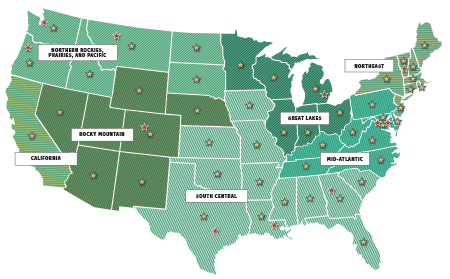Adopt a Wildlife Acre, Grow the Herd
The work that we began in the Tendoys eight years ago has restored a legacy to our western landscape.

Conflicts between livestock and wildlife on public lands have been ongoing for decades.
When federal agencies created public land grazing allotments more than a century ago, they were permitted almost anywhere grass was available. But as conservation on public lands evolved, the need to weigh and balance competing uses increased. This became more acute as Congress passed new laws dealing with multiple-use, conservation of watersheds, and protection of endangered species.
In situations where conflicts between livestock and wildlife are prolonged and intractable, the National Wildlife Federation believes that grazing retirements represent an equitable solution for livestock and wildlife interests. You can help by adopting a wildlife acre today.
Yellowstone National Park
Yellowstone is home to the most diverse assortment of wildlife found anywhere in North America. But once these iconic species leave the protected borders of the park—they are often at odds with neighboring ranchers who utilize public lands for livestock grazing. Grizzly bears and wolves are often killed or relocated when they attack livestock on National Forest lands where ranchers hold grazing privileges. In addition, magnificent wildlife including bison and bighorn sheep face great risks when they leave the park because of diseases they either carry or diseases that they may acquire from neighboring livestock.
Charles M. Russell National Wildlife Refuge
This incredible 1.1-million-acre refuge, along with adjacent public land, contains more intact shortgrass prairie habitat than anywhere else in America. Yet livestock still graze on much of the refuge, and species like sage-grouse, pronghorn antelope, elk and mule deer must compete with livestock for habitat.
The National Wildlife Federation’s Adopt a Wildlife Acre program addresses the conflicts between livestock and wildlife with a voluntary, market-based approach. We offer ranchers a fair price in exchange for their agreement to retire their public land grazing leases.
In most cases, livestock producers use our funds to relocate their livestock to areas without conflict. Wildlife has secure habitat, and rancher’s cattle can graze in an area with fewer problems. It’s a win-win situation!
What began as a small program retiring a few acres here and there has grown into a force of National Wildlife Federation members and supporters investing nearly $10 million towards grazing retirements and securing over 1.5 million acres of vital habitat for wildlife!
The program's top five priorities:
The National Wildlife Federation contacts ranchers who hold leases on allotments that are on our priority list for retirement. If the rancher is interested, we negotiate a price. We base the value for retiring the allotment on the number of livestock that graze a particular allotment. All agreements that are made are completely voluntary.
Next, we approach the land management agency (the U.S. Forest Service, Bureau of Land Management or the U.S Fish and Wildlife Service) to make sure they are willing to permanently close the allotment.
When all three parties voluntarily agree, the agency retires the grazing permit. Through this program, we recognize the economic value of livestock grazing permits and fairly compensate ranchers for retiring their leases.

American Bison
The American bison is an iconic symbol of the great American West. Once there were more than 50 million bison roaming the U.S. But today there are only a few thousand roaming free and managed as wildlife. When they leave the protected boundaries of Yellowstone National Park, they’re often killed by government agents in fear they’ll spread disease to nearby cattle. In one recent hard winter when many bison left the high elevation Park in search for food, more than 1,600 were killed.

Gray Wolf
The gray wolf was reintroduced to the Yellowstone area in 1995, and National Wildlife Federation was a leader in that effort. But more and more conflict with livestock has occurred as wolves have occupied new habitat across the West.

Grizzly Bear
Like the gray wolf, the Yellowstone grizzly population is much more secure when it remains in the park and its surrounding wilderness. When bears kill livestock on public lands near the park, government agents are often required to either kill or move them. The only significant grizzly populations remaining in the lower 48 states are in the Greater Yellowstone Area and in northwestern Montana, including Glacier National Park.

Bighorn Sheep
Diseases carried by domestic sheep are readily transferred to wild bighorn sheep populations and have caused long-term population declines in many areas across the west. Domestic sheep grazing on public lands near occupied bighorn sheep habitat pose a significant threat to the survival of this species.
The National Wildlife Federation has been hard at work since 2002 retiring livestock grazing allotments in the Northern Rockies and in 2017 expanded the reach of the program to the Southern Rockies and the Great Basin. Since that time, we have secured 150,000 acres of critical habitat in Colorado, New Mexico, and Utah bringing the total secured to well over 1.5 million acres over the life of the program.
Animals such as grizzlies, wolves, and bison that experience conflict with livestock now live securely thanks to these adopted and retired acres.
Thank you to our amazing members and supporters who have helped make this happen and given wildlife more room to roam.
Location: SW Montana in the Beaverhead-Deerlodge National Forest
Size: 12,069 acres
Wildlife: Bighorn sheep
Conflict:Domestic sheep are known to transmit diseases to bighorn sheep that can result in dramatic die-offs of the wild sheep
Location: SW Montana in the Gallatin National Forest
Size: 7,235 acres
Wildlife: Grizzly bears, wolves, bison
Conflict: Chronic trouble with cattle transmitting disease to grizzly bears, wolves, bison
Location: NW Wyoming in the Bridger-Teton National Forest
Size: 38,773 acres
Wildlife: Grizzly bears, wolves, cutthroat trout
Conflict: Chronic conflict between grizzly bears, wolves, cutthroat trout and cattle livestock
Location: Southwestern Montana
Size: 10,000 acres
Wildlife: Bison
Conflict: Bison were killed when they wandered outside Yellowstone National Park in search of food, for fear they would spread disease to cattle grazing nearby.
Location: SW Montana, northern border of Yellowstone National Park
Size: 6,000 acres
Wildlife: Bison
Conflict: Bison were killed in fear they would spread disease to local grazing livestock. Now, we’ve secured a 30-year leasing agreement to prohibit livestock grazing on Royal Teton Ranch. This has created a bison corridor along Yellowstone River that is a safe winter migration path for these animals.
Location: SW Montana in the Gallatin National Forest, NW of Yellowstone National Park
Size: 9,200 acres
Wildlife: Bison, grizzly bears, gray wolves
Conflict: Chronic conflict between large carnivores and cattle, possible bison habitat
Location: NW Wyoming in the Shoshone National Forest, South of Yellowstone National Park
Size: 34,500 acre allotment
Wildlife: Gray wolves, grizzly bears, elk, mule deer, bighorn sheep
Conflict: Severe conflict between cattle and wolves/grizzly bears; important winter range for elk, deer
Location: East Idaho on the Caribou-Targhee National Forest, West of Yellowstone National Park
Size: Five allotments secured as part of the Icehouse/Willow Creek retirement totaling 33,714 acres
Wildlife: Grizzly bears, gray wolves
Conflict: Grizzly bears and wolves preying on domestic sheep, being killed in return
Location: NW Wyoming in the Bridger-Teton National Forest, South of Yellowstone National Park
Size: 178,000 acres
Wildlife: Grizzly bears, gray wolves, elk, moose
Conflict: Grizzlies and wolves were experiencing chronic conflict with grazing livestock. Cattle were consuming forage important to wintering elk and moose.
ASH MOUNTAIN/IRON MOUNTAIN (RETIRED 2006)
Location: SW Montana in the Gallatin National Forest, NE side of Yellowstone National Park
Size: 74,000 acres
Wildlife: Grizzly bears, gray wolves, bighorn sheep
Conflict: This was a domestic sheep grazing allotment that experienced chronic problems with grizzly bears and wolves, which were sometimes killed in response to depredations. The domestic sheep were also believed to transmit diseases to nearby wild bighorn sheep.
Location: NW Wyoming on the Shoshone National Forest, East of Yellowstone National Park
Size: 16,800 acres
Wildlife: Grizzly bears, gray wolves, bighorn sheep
Conflict: Long-term conflict between gray wolves and grazing sheep, disease issues with bighorns
Location: NW Wyoming in the Bridger-Teton National Forest, South of Yellowstone National Park
Size: 67,500 acres
Wildlife: Gray wolves, bighorn sheep, mule deer, elk, grizzly bears
Conflict: Chronic conflict between sheep and wolves
Location: NW Wyoming in the Targhee National Forest, East of Yellowstone National Park
Size: 12,000 acres
Wildlife: Grizzly bears, gray wolves, bighorn sheep
Conflict: Grizzly bears and wolves preying on domestic sheep, sheep transmitting diseases to wild bighorns
Location: Eastern Idaho on the Caribou-Targhee National Forest, West of Yellowstone National Park
Size: Three allotments totaling 12,526 acres
Wildlife: Grizzly bears and wolves
Conflict: Long history of problems between grizzly bears and sheep. Retiring this acreage ended these conflicts and promoted connectivity in a critical wildlife corridor between Yellowstone, the Centennial Mountains, and the large central Idaho wilderness areas to the west.
Location: NW Wyoming in the Caribou-Targhee National Forest, South of Yellowstone National Park
Size: 24,500 acres
Wildlife: Moose, grizzly bears, black bears, gray wolves, bison, mule deer, elk
Conflict: Grizzly bears and sheep, major problem with domestic sheep transmitting disease to nearby bighorn herds
Location: NW Wyoming in the Bridger-Teton National Forest, South of Yellowstone National Park
Size: 87,000 acres
Wildlife: Grizzly bears, gray wolves, bison
Conflict: This allotment experienced more conflicts between cattle and grizzly bears than any other in the Yellowstone ecosystem.
Location: SW Montana on the Gallatin National Forest, West of Yellowstone National Park
Size: 2,200 acres
Wildlife: Bison
Conflict: Horse Butte has the distinction of being the very first allotment the National Wildlife Federation retired. Bison would wander onto Horse Butte in the winter and early spring in search of grass and would be shot. Now, Horse Butte is a safe place where they can graze.
Take the Clean Earth Challenge and help make the planet a happier, healthier place.
Learn MoreA groundbreaking bipartisan bill aims to address the looming wildlife crisis before it's too late, while creating sorely needed jobs.
Read MoreMore than one-third of U.S. fish and wildlife species are at risk of extinction in the coming decades. We're on the ground in seven regions across the country, collaborating with 52 state and territory affiliates to reverse the crisis and ensure wildlife thrive.
